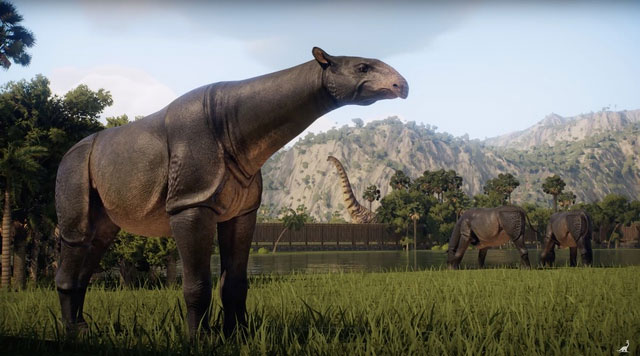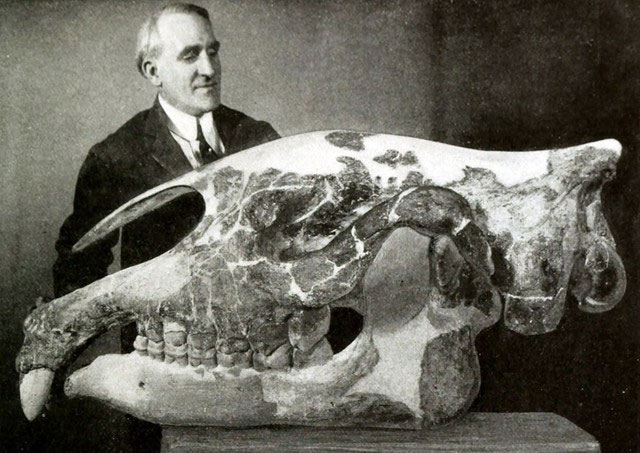The largest land mammal that ever lived was Paraceratherium - How big was it really?
Paraceratherium, also known as Indricotherium, is the largest known land mammal. Its enormous size makes it one of the most impressive creatures to ever walk the Earth.
The fossil remains of Paraceratherium reveal it to be an animal of almost unimaginable size. Its skull alone was more than 1.3 meters (4.3 feet) long. Instead of horns like modern rhinos, Paraceratherium had a domed forehead and a significantly long nasal slit, suggesting it had a prehensile upper lip or that it would have possessed tapir-like muscles.

Paraceratherium, a mammal with a height of about 5 meters at the shoulder, longer than two large pickup trucks and weighing about 15-20 tons - equal to 4 African elephants . This giant monster is a relative of the modern rhinoceros, which roamed the Earth millions of years ago during the Oligocene, about 34–23 million years ago.
Speaking of diet, the teeth of Paraceratherium had low crowns but were extremely strong – some molars were the size of a human fist! This indicates that they often strip leaves and twigs, and would need to consume large amounts of vegetation to maintain their massive mass.
Estimates of the animal's size vary widely in scientific studies, but most researchers believe that Paraceratherium was at least 4.8 meters (15.7 feet) tall at the shoulder – taller than many towers. single-storey house! Its pillar-like legs have slanting feet, each up to half a meter (20 inches) long. Notably, its limb bones show that Paraceratherium descended from much smaller and faster-running ancestors of early rhinos.

Paraceratherium is a herbivore, eating leaves, twigs and fruit. Their enormous height allows them to reach food sources that other animals cannot reach.
Recently, paleontologists discovered fossils of a new species of Paraceratherium which they named Paraceratherium linxiaense or 'Giant Linxia Rhinoceros' in northwestern China, representing the largest mammal in the world. the largest land ever to exist on Earth. Complete skull and jaw fossils analyzed by a Chinese-American research team show that this giant rhino weighed about 24 tons, was more than 4.9 meters (16 feet) tall at the shoulder, and had a long head. over a meter (more than 3 feet) long, and the body is nearly 8 meters (26 feet) long – the size of 5-6 elephants combined.
The giant rhinoceros Linxia lived about 31 million years ago in the northern Tibetan plateau before migrating southwest, with fossils also found in Mongolia, Kazakhstan, Pakistan and Eastern Europe during the Oligocene epoch .

Paraceratherium is closely related to today's rhinoceros. However, they are much larger in size and lack horns. Paraceratherium possessed a neck 2 to 2.5 meters (6.6 to 8.2 feet) long, allowing it to easily reach high tree foliage to feed.
In those days, the largest land predators were typically no larger than modern wolves, meaning that adult Paraceratherium posed virtually no threat except for extremely unlucky encounters with humans. big crocodiles. However, juveniles can still be vulnerable to predation. With its huge size, long lifespan and unlimited habitat range, Paraceratherium is considered to be at the top of the food chain during the Oligocene.

The Mammoth, considered one of the largest mammals, weighed only about 6 tons (13,200 pounds), significantly smaller than Paraceratherium. Some sauropod dinosaurs, such as Argentinosaurus, may have been longer than Paraceratherium, but Paraceratherium was significantly heavier. Paraceratherium became extinct at the end of the Oligocene, possibly due to climate change or competition from other mammals.
So how did these super beasts finally become extinct after thriving for about 11 million years? The exact cause remains a paleontological mystery. Perhaps competition from newly emerging proboscis species such as gomphotheres contributed to changes in the habitat and food sources of Paraceratherium. Perhaps the development of more effective predators during the early Miocene, along with cooling climate and changes in vegetation, eventually caused the species to become extinct. One thing is certain: the disappearance of Paraceratherium marked the end of an era of extremely large land mammals.

Paraceratherium was a giant and amazing creature that dominated Earth during the Oligocene period. Its enormous size and unique lifestyle make it one of the most fascinating mammals to ever exist.
With new fossil discoveries still being carefully excavated, our understanding of Paraceratherium continues to grow and develop. Countless questions remain about this animal's behavior, biology, and ultimate demise. However, Paraceratherium certainly holds the heavyweight championship in the large mammal circuit. But who knows? Maybe a future dig will uncover an even bigger rival!
- The largest carnivorous mammal on land, dubbed the 'mobile meat grinder'
- Discover the oldest mammal
- What will happen if you come to live at Chernobyl 'Dead Land' now?
- The most mysterious mystery of the planet pig
- The Earth is about to lose 1/3 of its food land
- Discovered the world's largest amphibian
- What would happen if the Earth's sea and land swapped? Hell is full of centipedes waiting for you
- Vietnam and ASEAN use peat land sustainably
- The tiny piece of private land is only 0.32m2 wide in the US city
- The sea hare's custom of 'love' is full of chaos
- A quarter of the world is degenerating
- Save the mermaids
 Discovered an ancient centipede fossil 99 million years old
Discovered an ancient centipede fossil 99 million years old Discovered bat-like dinosaurs in China
Discovered bat-like dinosaurs in China Discovered a 200-year-old bronze cannon of the coast
Discovered a 200-year-old bronze cannon of the coast Discover 305 million-year-old spider fossils
Discover 305 million-year-old spider fossils